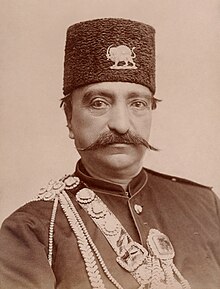User:Zereshk-sensei/Addiction in Iran
Addiction in Iran is a matter that has been a subject of attention of the Islamic Republic of Iran and experts for some years. According to official statistics published by Rasoul Khazari of the Islamic Consultative Assembly in 2013, at least 10 million out of the 75 million people in Iran (approximately 13%), are involved in narcotics.[1]

History[edit]
The Safavids[edit]
The consumption of narcotics in Iran has expanded since the Safavid dynasty and along with the propagation of opium poppy cultivation.[2] Until the reign of Shah Tahmasp I, the consumption of cannabis, opium, and hashish in Iran was accepted as a norm and was popular amongst the people, such as in coffeehouses and in the royal courts of the Safavid kingdom.[2][3] After Shah Tahmasp I, Shah Abbas the Great took measures to limit the consumption of opium in Iran. In the year 1597, he issued an order for the proscription of opium. In spite of this, the cultivation of the opium poppy continued in Iran during this period.[3]
The Qajars[edit]

During the Qajar dynasty, the production and consumption of narcotics in Iran increased and were supported by the government.[2] The cultivation of the opium poppy was carried out 18 provinces in Iran, and 7 varieties of opium existed in Iran. During the time of Naser al-Din Shah Qajar, addiction was a major phenomenon in Iran. During that same period, the exportation of opium was one of the sources of revenue income in Iran. [3]
Pahlavi Dynasty[edit]
The production and sale of opium by the government continued until the year 1941, when Reza Shah left Iran. In 1952, the "Law Prohibiting the Provision, Purchase, Sale, and Consumption of Alcoholic Drinks, Opium, and Their Derivatives" was ratified by the Iranian Parliament.
Islamic Republic[edit]
After the 1979 Revolution in Iran,
Smuggling of Narcotics and Increase in the Number of Addicts[edit]
According to some statistics, in the year 2021, as well as during the reign of the Islamic Republic of Iran, there more than 12 million drug addicts in Iran, of which 4.5 million are regular users. 10% of addicts are women, and thousands of addicts are children.[4]
Consumed Substances[edit]
Statistics on the Number of Addicts[edit]
Society as a Whole[edit]
Women[edit]
Universities[edit]
In the research of "The Basis of Addiction" that
Afghanistan[edit]
The proximity of opium cultivation fields in Afghanistan to Iranian soil has had a noticeable effect on the rate and statistics of addiction in Iran.[5]
Proposed Solutions[edit]
- Improving the surveillance of Iran's border, especially the border between Iran and Afghanistan, such as through border wall construction; laying landmines (much like the Uzbekistan-Tajikistan border); and increasing surveillance garrisons
- Promotion and raising awareness amongst people in the field of addictive substances in a basic manner and through education
Footnotes[edit]
External Links[edit]
- ^ "۱۰ میلیون ایرانی درگیر اعتیاد هستند". همشهری آنلاین (in Persian). 2013-09-11. Retrieved 2023-03-06.
- ^ a b c Ghanji, Ali (15 April 2008). "تاريخچه موادمخدر در ايران جغرافياي اجتماعي- اقتصادي و سياسي مواد مخدر- بخش اول" [History of Drugs in Iran, Socio-Economic and Political Geography of Drugs - Part One]. Mag Iran. Archived from the original on 23 July 2012. Retrieved 6 March 2023.
- ^ a b c Sargzazizadeh, Mahmoud (18 June 2006). "مواد مخدر در ایران و جهان" [Use of Narcotics in Iran and the World]. MagIran (in Persian). Retrieved 18 February 2018.
{{cite web}}: CS1 maint: url-status (link) - ^ "مواد مخدر در ایران: از میدان شوش تهران تا مکزیک". العربیه فارسی (in Persian). 2021-05-17. Retrieved 2023-03-06.
- ^ Beehner, Lionel (13 September 2006). "Afghanistan's Role in Iran's Drug Problem". Council on Foreign Relations. Retrieved 6 March 2023.
{{cite web}}: CS1 maint: url-status (link)
References[edit]
[[Category:Health in Iran]] [[Category:Addiction]] [[Category:Drugs in Iran]] [[Category:Articles with dead external links]]
